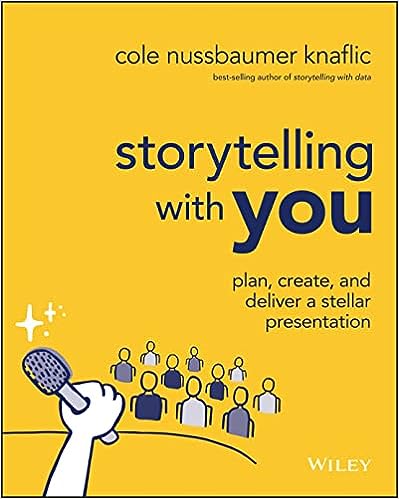I recently reviewed Cole Nussbaumer Knaflic’s Storytelling with data, as a result the storytelling team sent me a copy of Storytelling with you to review. Storytelling with you is the next step in the journey which started with Storytelling with data, widening the scope to talk more fully about the whole process of presenting from inception to delivery and not being concerned specifically with presenting data.
I’m a data scientist, previously an academic and then industrial research scientist. Presenting has been a constant throughout my career, both as an audience member and as a presenter. Yet it is something in which I have had relatively little training and given the quality of the presentations I have witnessed – I am not alone!
Those with a scientific background will be used to a standard way of presenting results that effectively replicates a scientific paper (introduction, methodology, results, discussion, conclusions). Knaflic’s earlier book proposed a break from this format: using ideas from storytelling to shape presentations. She cites Resonate by Nancy Duarte, as a reference for this approach. Storytelling with you is similar in content to Resonate but feels like a shorter, more focussed book.
The book is divided into three parts: plan, create and deliver. Each part comprises four chapters. Each chapter ends with an instalment of the “TRIX Case study”. TRIX is a trail mix product which requires revision and the presentation is about options for this revision. I really liked this, it enables Knaflic to provide examples of the material in each chapter without having to restate the context for each new outing. I have learnt that macadamia nuts are really important to the TRIX mix!
Planning starts with the audience, not the content. Who are they? What do they want? I find Linkedin is great for getting a quick view of audience members. In terms of content the plan starts with the Big Idea – the sentence that captures what the presentation is about. This is expanded into a full story using a storyboard based on Post-its.
Knaflic is keen on Post-Its for planning and organising material. My tendency when creating a presentation is to open up a PowerPoint file but this forces me into choices on format and so forth that I don’t need to make at the beginning. There is also a challenge in being unwilling to delete slides so carefully and laboriously created!
The section on the theory of storytelling is quite brief. One takeaway for me was to think of the children’s books you know as templates for storytelling. Over the last 10 years or so I have read a lot to my son so I am very familiar with a range of children’s books. I like Dr Seuss, and Julia Donaldson’s books – The Gruffalo, for example – not only do they provide a template for stories, they are designed to be read aloud and provide some ideas for delivery. For fun, you can even think about your presentation in the style of Dr Seuss!
The create section is very practical, including a walkthrough of how to use PowerPoint-like Slide Master – I found this welcome since whilst I am aware of the master slides my use of them is rather primitive. It also talks about font selection, picking a font which has a distinct bold form, and colour selection.
The appendix containing the completed slides for the TRIX case study is quite telling when I compare them to my own: the case study slides contain far less text and effectively no bullet points when compared to mine. The story of the presentation is read from the titles which summarise the slide they sit on rather than indicating the function of the slide.
In terms of content I found the section on images most interesting, corporate templates tend to have a bunch of images included, and I always feel the need to add an image to each slide – which is wrong.
There is a substantial section on delivery. I found the part on introducing yourself quite striking, it talks about picking out the characteristics which you wish to present and relating anecdotes that support them. I found this a bit calculated but realise I probably do this intuitively – I am notorious for my anecdotes!
I was bemused by the vision of Knaflic striking power poses in conference centre restrooms in preparation for presenting! She provides a lot of detail on how she prepares to deliver a presentation. I learnt long ago that practicing the opening is very important, I find it helps me to relax. Knaflic points out that practicing your ending is equally important – it sends your audience off into action.
In common with Resonate and Storytelling with data the assumption is that you are preparing for a high stakes meeting and you are going to commit a lot of time to this process. Typically I find I make lots of low stakes presentations so there is a degree to which I would adapt the lessons in this book to that scenario. In fact the storytelling team have recognised this, and produced a blog post on a reduced process.
If you’re looking for a readable guide to planning, creating and delivering presentations then this is the book for you!


